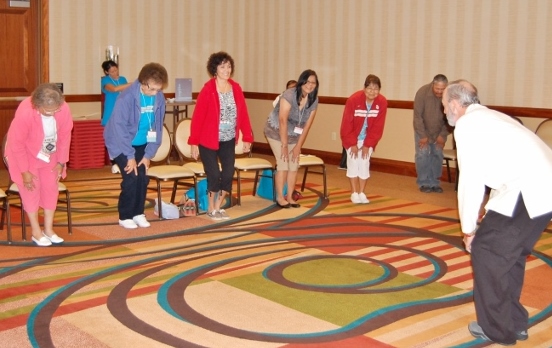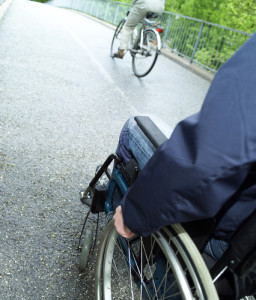by Christine Herman, NCAREE Technical Communications Manager for NICOA. This Post originally appeared on the NICOA blog.

While there are many factors that contribute to good health, diet and exercise remain key. In the not so distant past, American Indians and Alaska Natives (AI/AN) communities were largely untouched by the types of chronic disease that now plague us, like diabetes, heart disease and Alzheimer’s Disease. From the traditional diets to the higher levels of physical activity, AI/AN lifestyles were naturally healthier than those led by people in general today.
Exercise is one side of the coin leading to a healthier life. Becoming more physically active is something that most Elders can do, and there are a multitude of benefits that come along with getting up and moving.
Living Longer
Nobody ever said that “some exercise today will keep the doctor away,” but there is increasing evidence to show this might be the case. The New York Times reports that two studies of a broad segment of the population both point to strong evidence that exercise is directly linked to longevity. In one survey, it was found that those who exercised 150 minutes weekly (the US Department of Health and Human Services recommendation) were almost a third less likely to die when compared with those who never exercised over the 14-year survey period. (1)(2) The Times also reported that a study from Australia found that the type of exercise may matter, too. In this study, those who met the recommended exercise guidelines with moderate exercise were less likely to die than those who never exercised, and those who exercised with more intense workouts saw additional benefits to their longevity compared with those who simply exercised moderately. (2)
The Washington Post reported that the benefits have been demonstrated to be real for those of the Elder population. A study from Norway showed that over a 12-year survey period, men in their 60’s and 70’s were 40% less likely to die when they exercised 30 minutes per day, 6 days per week in comparison to those who did not exercise at all. This dramatic reduction in the risk of death was described as being comparable to that of a smoker quitting smoking.(3)
The benefits to regular exercise might be even more dramatic when you consider the return on the exercise investment. National Public Radio affiliate WBUR reports that for those meeting the exercise guidelines, every single minute of exercise may extend life by as much as seven or eight minutes. For someone who exercises the recommended 150 minutes – 2.5 hours – every week, they may live 17.5 hours longer. This study also showed that the benefits did increase with additional exercise. Over the span of a lifetime, the healthy habit of regular exercise can lead to substantial gains in the length of a lifetime – 4.5 years of additional life according to a study performed by the National Institutes of Health – and it all starts with a little daily exercise. (1)(4)
More Importantly, Living Better
While many are concerned with living longer, it’s even more important to enjoy a high quality of life – to be able to enjoy the time available. While numerous factors contribute to quality of life, health is undoubtedly one of them and health is strongly linked to regular physical activity.
This can be explained visually with the graphic below, For Elders, as age increases, many decrease their physical activity. The decrease in exercise is associated with a decrease in physical ability, decrease in muscle, decrease in energy, and an increase in fat. These changes in ability and physical appearance can prompt an Elder to start to “feel” and “act” older. They are also related to depression, stress, and anxiety for the Elder. The mental effects of aging, the depression and feelings of “being old” can then in turn promote further decreases in exercise and the reduction in the health of the body, as well as chronic disease. (5)

The negative impact of a sedentary lifestyle is also illustrated in a study conducted by the American Heart Association (AHA). The AHA reports people who watch 4 or more hours of television per day have a 46% increase in the chance of death from any cause and an 80% increase in their risk from dying of heart disease. (6) The AHA also reports a number of benefits to the quality of life for those who are physically active. Among these benefits are improvements in mental health, such as reductions in stress or depression and long-term improvements in mental wellbeing. The AHA also finds that increased physical activity can:
- reduce risks of heart disease and stroke;
- improve cholesterol levels;
- help prevent bone loss;
- help to avoid the onset of chronic diseases associated with aging;
- help Elders maintain their independence. (6)
Regular exercise is simply a part of a healthy lifestyle and it is crucial for Elders to keep moving now in order to keep moving later.
How To Exercise
 Exercise is something that most Elders of any age can do. For those who have not exercised for a long time, it is advisable to start slow and to consult with a doctor for advice. One way to get the physical activity you need to be healthy is to try to exercise every day. Just 20-25 minutes per day will help you achieve the AHA recommended 150 minutes of weekly exercise. Starting easy and working up to more vigorous exercise is the key to making a valuable change to improve one’s health, and to invest in the future.
Exercise is something that most Elders of any age can do. For those who have not exercised for a long time, it is advisable to start slow and to consult with a doctor for advice. One way to get the physical activity you need to be healthy is to try to exercise every day. Just 20-25 minutes per day will help you achieve the AHA recommended 150 minutes of weekly exercise. Starting easy and working up to more vigorous exercise is the key to making a valuable change to improve one’s health, and to invest in the future.
While there are a variety of different ways to get exercise, one of the easiest is to take a brisk walk. Walking does not require special equipment of any kind – just comfortable shoes and a flashlight if going out in the early morning or late evening hours. For those more comfortable staying indoors, local community centers often times have resources like exercise equipment available without the cost of a gym. If unsure about what exercise is appropriate, consult a doctor to help you assess your specific health and exercise needs.
Resources
Start simple. The Indian Health Service (IHS) recommends walking for 30 minutes, 5 days per week. The IHS also suggests daily stretching and doing exercises 2 or 3 times per week, recommending 10 to 15 repetitions of 8 to 10 exercises per exercise session. (7)
For assistance on finding exercises to do safely at home, the Centers for Disease Control (CDC) offers the following resource:
http://www.cdc.gov/physicalactivity/growingstronger/exercises/index.html
The National Resource Center on Native American Aging (NRCNAA) offers the WELL Balanced 8-week curriculum free of charge. Downloads include curriculum and booklets for program participants:
https://www.nrcnaa.org/well-balanced
Don’t forget to check out NICOA’s Tribal Footprints resource directory to find exercise resources in your area.
https://www.Tribalfootprints.org
Sources:
- CCI Press Office (2012). NIH Study Finds Leisure-time Physical Activity Extends Life Expectancy As Much As 4.5 Years. Retrieved January 2016, from the National Cancer Institute: http://www.cancer.gov/news-events/press-releases/2012/PhysicalActivityLifeExpectancy
- Reynolds, Gretchen (2015). The Right Dose of Exercise For A Longer Life. Retrieved January 2016, from The New York Times: http://well.blogs.nytimes.com/2015/04/15/the-right-dose-of-exercise-for-a-longer-life/?_r=0
- Geggel, Laura (2015). 30 Minutes of Exercise Can Increase Longevity Even If You’re 60 or 70. Retrieved January 2016, from The Washington Post: https://www.washingtonpost.com/national/health-science/30-minutes-of-exercise-can-increase-longevity-even-if-youre-60-or-70/2015/05/18/f80967ee-fb02-11e4-a13c-193b1241d51a_story.html
- Goldberg, Carey (2013). Every Minute of Exercise Could Lengthen Your Life Seven Minutes. Retrieved January 2016, from Common Health: http://commonhealth.wbur.org/2013/03/minutes-exercise-longer-life
- Berger, Bonnie G. The Role of Physical Activity in the Life Quality of Older Adults. Retrieved January 2016, from the National Academy of Kinesiology.
- American Heart Association (2012). Physical Activity Improve Quality of Life. Retrieved January 2016 from American heart Association
- Indian Health Service, Health Promotion/Disease Prevention. Retrieved January 2016, from the Indian Health Services: http://www.ihs.gov/hpdp/index.cfm?module=dsp_hpdp_resources_physicalactivitykit
The opinions expressed in this article are those of the author and do not necessarily reflect those of the Diverse Elders Coalition.

